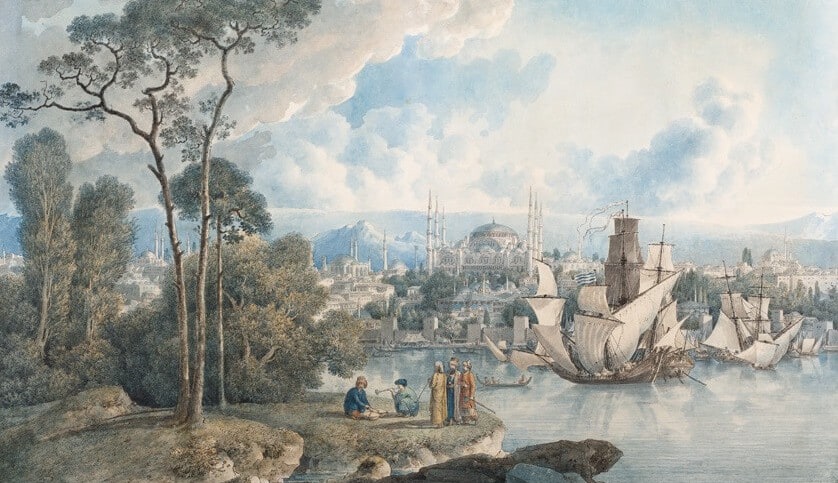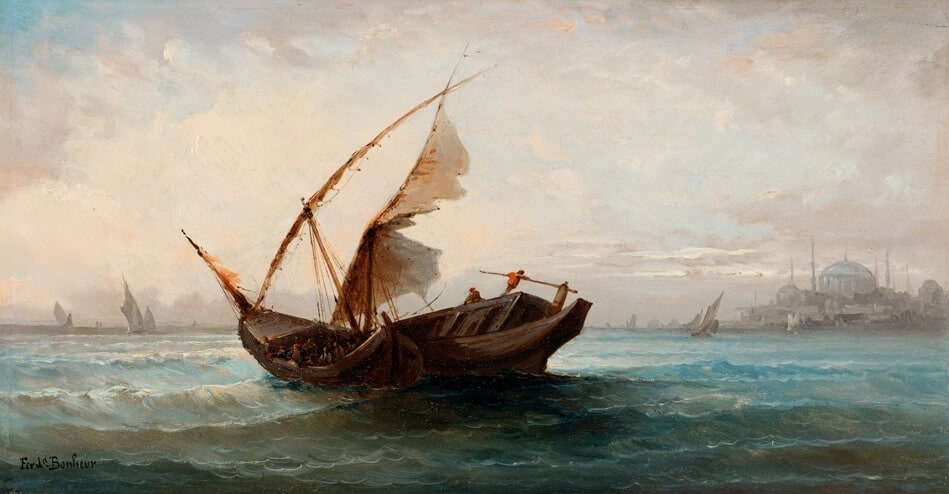22 September 2017
With the Topkapı Palace, the center of political authority until the 19th century, and many other examples of classical Ottoman and Byzantine architecture included in its premise the Historical Peninsula is the heart of the Empire. Every westerner who wants to be thoroughly acquainted with the Ottoman Empire must first view the Historical Peninsula, even if by means of paintings. Often, because the painters had no other choice, the peninsula was depicted as viewed from the embassies located in Pera until the second half of the 19th century. Additionally, this location provided the best perspective from which one can view the city’s topography, the maritime transportation facilities, the shipyards and boathouses of the Golden Horn, the position of the Prince Islands that generate the first visual impression of the town for westerners, and even Uludağ, one of the mountains called Olympus in the ancient times.
We have prepared a selection for you from the sceneries found in the Suna and İnan Kıraç Foundation Orientalist Painting Collection!

In this view, the Historical Peninsula is featured from Galata, in a manner that includes the shores of the Golden Horn and Tophane. The entrance to the Bosphorus and Kadıköy shores are visible in the background. The Italian names of the Topkapı Palace, important structures, the shipyard, ports and some districts are conveyed in letter codes in the lower section of the painting. The Ottoman galleys at sea are meticulously depicted. While the coat of arms of the commissioner is visible at the bottom of the painting, its details remain indiscernible. The location of the Kaptanpaşa Palace next to the shipyard dates the paintings to the second half of the 18th century. Identical in size, both paintings feature similar naïve characteristics of style.

This panoramic composition of Cassas, which centers on the Topkapı Palace, is likely to have been created upon his return to his country and is based on the drawings he made during the time he lived in İstanbul. It is known that during his second visit to İstanbul in 1786, the artist made approximately 30 drawings, portraying the major structures and the overall view of the city. The composition is bordered by the entrance to the Bosphorus and Kadıköy on the left, and the Sultanahmed Mosque on the right. For this typical view of İstanbul, similar examples of which have been painted by European traveler-artists since the 16th century, Cassas presumably used the drawings he made from the balcony of the French Palace or gardens of the Swedish Palace. While the artist often includes figures and details from daily life in his landscapes, in this particular work, he also reveals the commotion at sea through a depiction of sailboats, commercial boats, and imperial caiques with kiosks (stern pavilions) in front of Haliç and Sarayburnu. A similar work by Cassas, which also offers a view of Galata with the flora and the graveyard in the foreground, is part of the collection of Musée de Valenciennes in France.

Painted from Pera and Galata, this Cassas composition diverges from the traditional Sarayburnu composition and depicts the Historical Peninsula from a different angle by placing the Sultanahmed Mosque at its center. Created after his return to France, the painting is based on the sketches that the artist made during his stay in İstanbul. A sketch preserved in the inventory of Wallraf-Richartz Museum in Cologne reflects the same composition as this painting and offers valuable insight into Cassas’s technique of İstanbul paintings vis-à-vis this watercolor created at a later date. While the artist’s note “Kadıköy Point from Fenerbahçe” on the sketch appears confusing, the angle from which we see the Historical Peninsula indicates that it was painted from Kadıköy. The sailboats seen in the watercolor are not included in the said sketch; there are also variations in the figures in the foreground and the urban texture. Cassas must have added details from his memory to the sketch he made in İstanbul. It can be argued that in this sense, the painting resembles a capriccio.

While there is no record confirming the artist’s visit to the city, Bonheur has a number of İstanbul cityscapes that combine local figures with views of the city. With a strong emphasis on the sea, these images incorporate the architectural elements that reflect the Orient image in a manner that recalls the “capriccio” style to create an İstanbul atmosphere. The artist, who presents a beautiful example of a Romantic seascape painting in this work, depicts in the foreground a rather dramatic scene with boats struggling against the strong wind and waves. Placed in the background is a mosque silhouette of unrealistic, exaggerated proportions, to suggest that the city is in fact İstanbul.

When regarding the paintings of Istanbul by western painters, Golden Horn has a distinctive place and value. This body of water that separates the Topkapı Palace and the Historical Peninsula, in which monumental edifices are located, from Galata, where westerners and foreign embassies dwell, is as though an interpenetrating boundary.
Tuesday - Saturday 10:00 - 19:00
Friday 10:00 - 22:00
Sunday 12:00 - 18:00
The museum is closed on Mondays.
On Wednesdays, the students can
visit the museum free of admission.
Full ticket: 300 TL
Discounted: 150 TL
Groups: 200 TL (minimum 10 people)